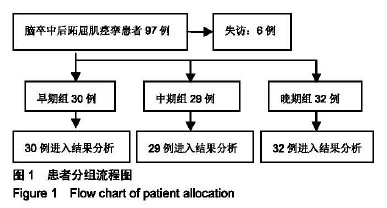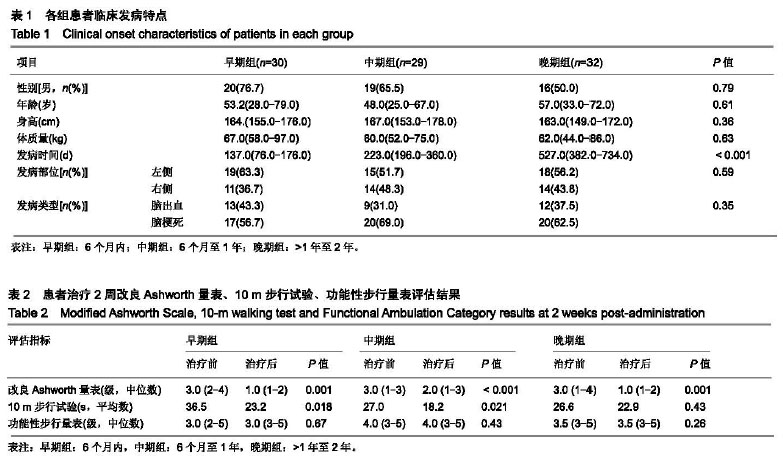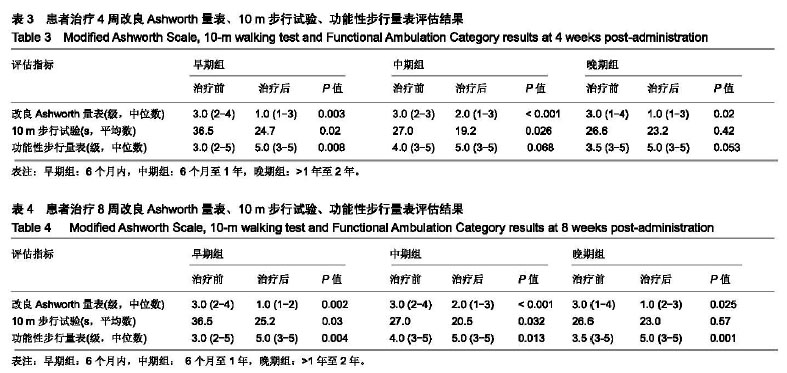中国组织工程研究 ›› 2019, Vol. 23 ›› Issue (27): 4300-4304.doi: 10.3969/j.issn.2095-4344.1375
• 肌肉肌腱韧带组织构建 tissue construction of the muscle, tendon and ligament • 上一篇 下一篇
超声引导下A型肉毒毒素治疗卒中后不同时期的跖屈肌痉挛
马善新,许建文,龙耀斌,黄 浪,付水生,苏义基,刘 莹
- (广西医科大学第一附属医院康复医学科,广西壮族自治区南宁市 530021)
Botulinum toxin type A under ultrasound guidance for treating plantar flexor spasticity on different stages after stroke
Ma Shanxin, Xu Jianwen, Long Yaobin, Huang Lang, Fu Shuisheng, Su Yiji, Liu Ying
- (Department of Rehabilitation, the First Affiliated Hospital of Guangxi Medical University, Nanning 530021, Guangxi Zhuang Autonoous Region, China)
摘要:
文章快速阅读:
.jpg)
文题释义:
A型肉毒毒素:为白色疏松体,生理氯化钠溶液溶解后为澄清透明或淡黄色溶液。适用于眼睑痉挛、面肌痉挛等成人患者及某些斜视,特别是急性麻痹性斜视、共同性斜视、内分泌肌病引起的斜视及无法手术矫正或手术效果不佳的12岁以上的斜视患者。2008年,国家卫生部、国家食品药品监督管理局(SFDA)联合下发《关于将A型肉毒毒素列入毒性药品管理的通知》,将A型肉毒毒素及其制剂列入毒性药品管理,并规定,药品批发企业只能将A型肉毒毒素制剂销售给医疗机构。
肌张力:简单地说就是肌细胞相互牵引产生的力量。肌肉静止松弛状态下的紧张度称为肌张力。肌张力是维持身体各种姿势以及正常运动的基础,并表现为多种形式。如人在静卧休息时,身体各部肌肉所具有的张力称静止性肌张力。躯体站立时,虽不见肌肉显著收缩,但躯体前后肌肉亦保持一定张力,以维持站立姿势和身体稳定,称为姿势性肌张力。肌肉在运动过程中的张力称为运动性肌张力,是保证肌肉运动连续、平滑(无颤抖、抽搐、痉挛)的重要因素。
.jpg)
文题释义:
A型肉毒毒素:为白色疏松体,生理氯化钠溶液溶解后为澄清透明或淡黄色溶液。适用于眼睑痉挛、面肌痉挛等成人患者及某些斜视,特别是急性麻痹性斜视、共同性斜视、内分泌肌病引起的斜视及无法手术矫正或手术效果不佳的12岁以上的斜视患者。2008年,国家卫生部、国家食品药品监督管理局(SFDA)联合下发《关于将A型肉毒毒素列入毒性药品管理的通知》,将A型肉毒毒素及其制剂列入毒性药品管理,并规定,药品批发企业只能将A型肉毒毒素制剂销售给医疗机构。
肌张力:简单地说就是肌细胞相互牵引产生的力量。肌肉静止松弛状态下的紧张度称为肌张力。肌张力是维持身体各种姿势以及正常运动的基础,并表现为多种形式。如人在静卧休息时,身体各部肌肉所具有的张力称静止性肌张力。躯体站立时,虽不见肌肉显著收缩,但躯体前后肌肉亦保持一定张力,以维持站立姿势和身体稳定,称为姿势性肌张力。肌肉在运动过程中的张力称为运动性肌张力,是保证肌肉运动连续、平滑(无颤抖、抽搐、痉挛)的重要因素。
摘要
背景:A型肉毒毒素用于治疗脑卒中患者下肢痉挛的理想时间目前尚无统一定论。
目的:分析A型肉毒毒素治疗卒中后不同时期跖屈肌痉挛的效果是否存在差异。
方法:纳入脑卒中后跖屈肌痉挛患者97例,其中失访6例。临床研究的实施符合广西医科大学第一附属医院对研究的相关伦理要求。根据跖屈肌痉挛发病时间将患者划分为3组:30例早期组(6个月内),29例中期组(6个月至1年),32例晚期组(>1至2年)。超声引导下给予患者腓肠肌、比目鱼肌、胫骨后肌各注射A型肉毒毒素100 U(合并有足内翻者同时选取胫骨后肌注射A型肉毒毒素80 U),每块肌肉注射2个点。注射后配合常规康复训练:每日1次,每周6次,连续治疗8周。注射后2,4,8周应用改良Ashworth量表、10 m步行试验、功能性步行量表(FAC)对治疗效果进行评价。
结果与结论:①3组患者在注射后的步态和痉挛程度均有所改善,注射后2周改良Ashworth量表评估中位数值显著减小(P < 0.001);②注射后4和8周3组患者功能性步行量表中位数值显著增大(P < 0.001);③10 m步行试验早期组能产生更大的步态速度变化;④结果说明,对于不同时期卒中后跖屈肌痉挛患者,进行A型肉毒毒素治疗都有望持续降低患者的肌张力和改善步态;尤其是早期(6个月以内) 注射A型肉毒毒素治疗效果更加明显。
背景:A型肉毒毒素用于治疗脑卒中患者下肢痉挛的理想时间目前尚无统一定论。
目的:分析A型肉毒毒素治疗卒中后不同时期跖屈肌痉挛的效果是否存在差异。
方法:纳入脑卒中后跖屈肌痉挛患者97例,其中失访6例。临床研究的实施符合广西医科大学第一附属医院对研究的相关伦理要求。根据跖屈肌痉挛发病时间将患者划分为3组:30例早期组(6个月内),29例中期组(6个月至1年),32例晚期组(>1至2年)。超声引导下给予患者腓肠肌、比目鱼肌、胫骨后肌各注射A型肉毒毒素100 U(合并有足内翻者同时选取胫骨后肌注射A型肉毒毒素80 U),每块肌肉注射2个点。注射后配合常规康复训练:每日1次,每周6次,连续治疗8周。注射后2,4,8周应用改良Ashworth量表、10 m步行试验、功能性步行量表(FAC)对治疗效果进行评价。
结果与结论:①3组患者在注射后的步态和痉挛程度均有所改善,注射后2周改良Ashworth量表评估中位数值显著减小(P < 0.001);②注射后4和8周3组患者功能性步行量表中位数值显著增大(P < 0.001);③10 m步行试验早期组能产生更大的步态速度变化;④结果说明,对于不同时期卒中后跖屈肌痉挛患者,进行A型肉毒毒素治疗都有望持续降低患者的肌张力和改善步态;尤其是早期(6个月以内) 注射A型肉毒毒素治疗效果更加明显。
中图分类号:



.jpg) #br#
文题释义:#br#
A型肉毒毒素:为白色疏松体,生理氯化钠溶液溶解后为澄清透明或淡黄色溶液。适用于眼睑痉挛、面肌痉挛等成人患者及某些斜视,特别是急性麻痹性斜视、共同性斜视、内分泌肌病引起的斜视及无法手术矫正或手术效果不佳的12岁以上的斜视患者。2008年,国家卫生部、国家食品药品监督管理局(SFDA)联合下发《关于将A型肉毒毒素列入毒性药品管理的通知》,将A型肉毒毒素及其制剂列入毒性药品管理,并规定,药品批发企业只能将A型肉毒毒素制剂销售给医疗机构。#br#
肌张力:简单地说就是肌细胞相互牵引产生的力量。肌肉静止松弛状态下的紧张度称为肌张力。肌张力是维持身体各种姿势以及正常运动的基础,并表现为多种形式。如人在静卧休息时,身体各部肌肉所具有的张力称静止性肌张力。躯体站立时,虽不见肌肉显著收缩,但躯体前后肌肉亦保持一定张力,以维持站立姿势和身体稳定,称为姿势性肌张力。肌肉在运动过程中的张力称为运动性肌张力,是保证肌肉运动连续、平滑(无颤抖、抽搐、痉挛)的重要因素。
#br#
文题释义:#br#
A型肉毒毒素:为白色疏松体,生理氯化钠溶液溶解后为澄清透明或淡黄色溶液。适用于眼睑痉挛、面肌痉挛等成人患者及某些斜视,特别是急性麻痹性斜视、共同性斜视、内分泌肌病引起的斜视及无法手术矫正或手术效果不佳的12岁以上的斜视患者。2008年,国家卫生部、国家食品药品监督管理局(SFDA)联合下发《关于将A型肉毒毒素列入毒性药品管理的通知》,将A型肉毒毒素及其制剂列入毒性药品管理,并规定,药品批发企业只能将A型肉毒毒素制剂销售给医疗机构。#br#
肌张力:简单地说就是肌细胞相互牵引产生的力量。肌肉静止松弛状态下的紧张度称为肌张力。肌张力是维持身体各种姿势以及正常运动的基础,并表现为多种形式。如人在静卧休息时,身体各部肌肉所具有的张力称静止性肌张力。躯体站立时,虽不见肌肉显著收缩,但躯体前后肌肉亦保持一定张力,以维持站立姿势和身体稳定,称为姿势性肌张力。肌肉在运动过程中的张力称为运动性肌张力,是保证肌肉运动连续、平滑(无颤抖、抽搐、痉挛)的重要因素。